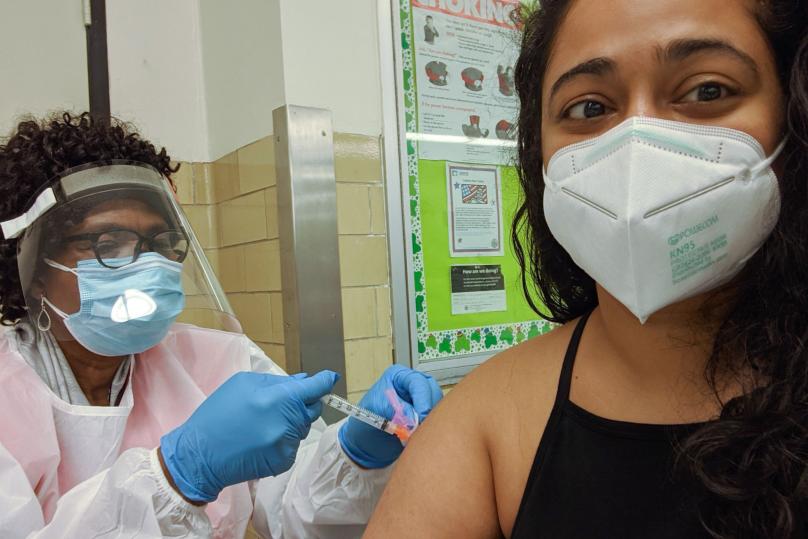
After attending a virtual lecture presented by a leading vaccinologist on the cutting-edge science behind the new COVID-19 vaccines, MƒA Master Teachers Sarah Tazghini and Pooja Bhaskar are using the information to inspire students and spread scientific awareness in their communities.
In December 2020, MƒA Master Teachers Sarah Tazghini and Pooja Bhaskar jumped at the chance to attend a virtual lecture hosted by MƒA, in which a leading vaccinologist, Dr. Florian Krammer, presented the science behind the new COVID-19 vaccines. More than 300 teachers from across the state joined the webinar.
Tazghini and Bhaskar had similar motivations for attending. “I wanted to be able to gain insight on the COVID-19 vaccine, so I could share the information with my students and make it more applicable for them,” Tazghini said.
“The biggest impact MƒA has had on me has been in growing my confidence as a scientist,” Bhaskar said. “In the current vaccine conversation, people who are able to understand science and also communicate have been especially needed in communities.” This is particularly important in Bhaskar’s school, the International High School for Health Sciences in Queens, where their student population consists primarily of recent immigrants and people of color with historical distrust of medical institutions.
During the workshop, Krammer, a professor of vaccinology at the Icahn School of Medicine at Mount Sinai in New York, explained that the U.S. government had already authorized two COVID-19 vaccines, by Pfizer-BioNTech and Moderna, with large-scale Phase 3 trials planned for three more. He talked educators through the cutting-edge science behind each of the different vaccines, how they have been developed so quickly versus traditional vaccines, and how they compare in terms of safety and efficacy.
Krammer’s presentation gave Tazghini an idea. For her spring unit on homeostasis, she will teach her freshman biology students the process by which the body maintains its equilibrium by having them study the body’s immune response to COVID-19, research the different vaccines that have been developed, and build an argument for the use of one vaccine over the rest.
The idea fits perfectly with Tazghini’s teaching philosophy at Fort Hamilton High School in Brooklyn. “My role as a teacher is to equip [students] with resources and methods of obtaining resources,” she said. “They’re the ones who are active participants in their own learning.”
“The biggest impact MƒA has had on me has been in growing my confidence as a scientist. In the current vaccine conversation, people who are able to understand science and also communicate have been especially needed in communities.”
To develop the new project, Tazghini said she will draw on her experience in an MƒA Professional Learning Team focused on Argument Driven Inquiry, a teaching method that requires students to create their own arguments based on real scientific data collected from different sources.
Tazghini believes that the best way to convince students that they can be scientists is to give them opportunities to engage in real science.
“This virus, as well as the vaccines, have impacted our entire world,” Tazghini said. “This is going to be an opportunity for students to not only apply their knowledge of scientific topics that they’ve been able to immerse themselves in during the academic year...but to use their voice, and have shared authority.”
Bhaskar was able to immediately apply the new science from Krammer’s talk to the benefit of their entire school community. After attending the lecture, they started writing regular emails to the school staff to address new developments and questions about the vaccines, while responding to emerging anxieties about availability. They hope to host a short presentation in English and Spanish to parents about the science and accessibility of vaccines.
Like Tazghini, Bhaskar is also using the talk to enrich their lessons, but in less structured ways, such as leaving 10-15 minutes at the beginning of every class to discuss vaccines and vaccination. They believe their work illustrates how treating teachers as authentic members of the scientific community creates a ripple effect that goes beyond their individual classrooms.
“Many teachers are afraid of science and do not feel like they can broach topics like vaccination with their students, but teachers are often the adults that students trust the most,” Bhaskar said. “Students who are recent immigrants, like mine, are often the ones in their family with the most access to information because of greater English competency, and consequently hold authority within their family.”
“If I teach my students how this vaccine works, they can teach their family,” they said. “If I can teach my fellow teachers about how this vaccine works, they can teach their students and those students can teach their families.”
